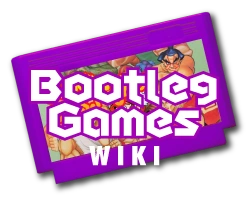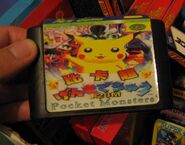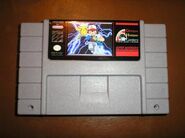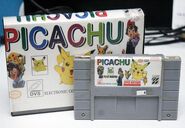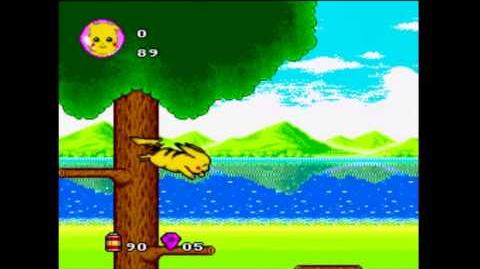(→Trivia) Tag: Visual edit |
(Adding categories) |
||
| (21 intermediate revisions by 14 users not shown) | |||
| Line 7: | Line 7: | ||
|publisher = [[DVS Electronic Co.]] (SNES version)<br>[[Unite Lucky Technology|X-Boy]](?) (MD version) |
|publisher = [[DVS Electronic Co.]] (SNES version)<br>[[Unite Lucky Technology|X-Boy]](?) (MD version) |
||
|developer = DVS Electronic Co. (SNES version)<br>[[Chuanpu Technology|Ex-Chuanpu]](?) (MD Version) |
|developer = DVS Electronic Co. (SNES version)<br>[[Chuanpu Technology|Ex-Chuanpu]](?) (MD Version) |
||
| + | |date = |
||
| + | September 1998 (SNES version) |
||
| + | December 2000 (Mega Drive version) |
||
|console = Sega Mega Drive, SNES |
|console = Sega Mega Drive, SNES |
||
|sound = High Seas Havoc (Mega Drive)<br>Bonkers (SNES) |
|sound = High Seas Havoc (Mega Drive)<br>Bonkers (SNES) |
||
}} |
}} |
||
| − | '''''Pocket Monster''''' is an unlicensed platformer based off the |
+ | '''''Pocket Monster''''' is an unlicensed platformer based off the ''Pokémon'' series for the Mega Drive and SNES. The SNES version is credited to [[DVS Electronic Co.]], while the Mega Drive iteration seems to be developed by ex-workers from [[Chuanpu Technology|Chuanpu]] and published by [[Unite Lucky Technology|X Boy]]. The game appears to have been released in 2000, as hinted by details on the box art. |
== Overview == |
== Overview == |
||
| − | [[File:PocketMonsterMDGameplay.png|thumb|left |
+ | [[File:PocketMonsterMDGameplay.png|thumb|left|''Pocket Monster''<nowiki>'</nowiki>s gameplay (Mega Drive version).]] |
| − | Like the Famicom pirate, the player controls Pikachu through numerous |
+ | Like the Famicom pirate, the player controls Pikachu through numerous side-scrolling levels. There are 5 levels in total, with a boss at the end of each, as well as a mini-boss in the first level of the Mega Drive version. Pikachu can jump on enemies and uses a special move which clears all of the enemies on the screen, although the latter can only be done when the charge meter is full (indicated by a power bar at the top of the screen of the SNES version, or a numeric counter in the Mega Drive version, which is full when it hits 20.) The player can start either with 3 and 5 lives and continues each, and there's a difficulty setting in the options menu. A sequel to this game was made for the Mega Drive, ''[[Pocket Monster II]]''. The ending is an image of some Pikachus. |
| − | The graphics are ripped from numerous sources. The backgrounds are ripped from numerous Mega Drive games, including ''Tiny Toon Adventures: Buster's Hidden Treasure'', ''Mr. Nutz'', ''Quackshot'', ''Magical Taruruuto- |
+ | The graphics are ripped from numerous sources. The backgrounds are ripped from numerous Mega Drive games, including ''Tiny Toon Adventures: Buster's Hidden Treasure'', ''Mr. Nutz'', ''Quackshot'', ''Magical Taruruuto-Kun'', and ''Monster World IV''. The graphics from the latter aren't present in the SNES version. The level graphics of the fourth and the last stage of the SNES version was ripped from ''Skyblazer''. Some of the enemy sprites are ripped from ''Syd of Valis'', and one of the enemy sprites appears to be taken from ''Super Metroid''. The intro, as well as several other graphics, are taken from the ''Pokémon'' anime. |
| − | The music in the Mega Drive version seems to be mostly original, although the opening theme is based on the Goten vs. Trunks theme of ''Dragon Ball Z: Super Butouden 3'' (also used in the bootleg ''[[Dragon Ball: Final Bout]]''), and there is music from ''[[Shui Hu Feng Yun Zhuan]]'' (2nd stage, bosses and last stage, also used in |
+ | The music in the Mega Drive version seems to be mostly original, although the opening theme is based on the Goten vs. Trunks theme of ''Dragon Ball Z: Super Butouden 3'' (also used in the bootleg ''[[Dragon Ball: Final Bout]]''), and there is music from ''[[Shui Hu Feng Yun Zhuan]]'' (2nd stage, bosses and last stage, also used in [[MK5 - Mortal Combat - Sub Zero|''Mortal Combat 5'']]) and ''[[Hercules 2]]'' (3rd stage). Strangely, in the Mega Drive version, Pikachu constantly says his name on the title screen, when hit and upon losing a life while he's mute in the SNES game. This is probably because the SNES version's audio is an unedited rip from the game ''Bonkers'' and it might've been too difficult to do digitized audio on the system. |
| − | == Differences Between Mega Drive/Genesis And SNES Versions == |
+ | == Differences Between Mega Drive / Genesis And SNES Versions == |
| − | *The Mega Drive version doesn't credit |
+ | *The Mega Drive version doesn't credit the company which made it, while the SNES version claims to have been made by DVS Electronic Co. |
*The music is completely different in both games, with the Mega Drive version having a mix of original music and music from ''Shui Hu Feng Yun Zhuan'' and ''Hercules 2'', while the SNES version takes the music from ''Bonkers''. |
*The music is completely different in both games, with the Mega Drive version having a mix of original music and music from ''Shui Hu Feng Yun Zhuan'' and ''Hercules 2'', while the SNES version takes the music from ''Bonkers''. |
||
*The sound effects are also different in the two games, although with both they're in PCM format. One of them in the Mega Drive version is taken from ''Michael Jackson's Moonwalker''. |
*The sound effects are also different in the two games, although with both they're in PCM format. One of them in the Mega Drive version is taken from ''Michael Jackson's Moonwalker''. |
||
| Line 29: | Line 32: | ||
*The mini-boss in the first level isn't in the SNES version. |
*The mini-boss in the first level isn't in the SNES version. |
||
*Many of the bosses in the SNES version are smaller and follow a set movement pattern. |
*Many of the bosses in the SNES version are smaller and follow a set movement pattern. |
||
| − | *The fourth and fifth levels are completely different, aside from boss of level four. |
+ | *The fourth and fifth levels are completely different, aside from the boss of level four. |
| − | *In the ending, the background scrolls in the Mega Drive version while there's an |
+ | *In the ending, the background scrolls in the Mega Drive version while there's an end message in the SNES version. |
| − | *In the Mega Drive version, Pikachu can jump |
+ | *In the Mega Drive version, Pikachu can jump mid-air while moving upward after bouncing off an enemy. This is also present in ''Pocket Monster II''. |
*In the Mega Drive version, you fight Onix as the final boss. In the SNES version, you fight recolors of the previous bosses with A.I. differences. |
*In the Mega Drive version, you fight Onix as the final boss. In the SNES version, you fight recolors of the previous bosses with A.I. differences. |
||
| − | *The |
+ | *The box art of the Mega Drive version features a picture of Pikachu traced from the cover of a N64-exclusive title ''Hey You, Pikachu!'' as well as several logos such as "New Game" and "2000", all covering the cover art of another N64 exclusive, ''Pokemon Stadium 2'', as well as the original Nintendo and N64 logos. One half of the game's logo also comes from ''Hey You, Pikachu!'', making its' title half-Chinese and half-Japanese; in its' entirety, it reads as 皮卡丘 げんきでちゅう (''Píkǎqiū Gen Ki De Chu''). |
== Trivia == |
== Trivia == |
||
| + | [[File:Pocketmonsters-snes-antipiracy.gif|thumb|]] |
||
| ⚫ | |||
| + | *Oddly enough, there is an anti-piracy check in the SNES version of the game. If the game detects it has been pirated, the animation of Ash scrolling upward in the intro will loop endlessly. Whenever a similar anti-piracy check exists in the Genesis version is unknown. |
||
| ⚫ | |||
| ⚫ | |||
| ⚫ | |||
| + | *When tested on an [[AtGames]] Sega Genesis Ultimate Portable Game Player, The game just loads a black screen. |
||
| + | *The PCB of the SNES version reads D1B9809, suggesting it was released first in September 1998 while the Mega Drive version was released later. |
||
== Gallery == |
== Gallery == |
||
| Line 47: | Line 54: | ||
Picachu-snes.jpg|Original SNES box and cartridge. |
Picachu-snes.jpg|Original SNES box and cartridge. |
||
Picachu SNES plastic box.jpg|SNES alternate plastic box and cartridge. |
Picachu SNES plastic box.jpg|SNES alternate plastic box and cartridge. |
||
| + | Tbtbt.png|Comparison of the same enemy sprite between "Pocket Monsters" (Left) and its source ("Syd of Valis", Right) |
||
</gallery> |
</gallery> |
||
== Videos == |
== Videos == |
||
<gallery> |
<gallery> |
||
| − | Pirate Showcase -2- Pocket Monsters| |
+ | Pirate Showcase -2- Pocket Monsters|Mega Drive version. |
Super Nintendo Longplay - Pocket Monster|SNES version. |
Super Nintendo Longplay - Pocket Monster|SNES version. |
||
</gallery> |
</gallery> |
||
| Line 61: | Line 69: | ||
[[Category:DVS Electronic Co.]] |
[[Category:DVS Electronic Co.]] |
||
[[Category:X Boy]] |
[[Category:X Boy]] |
||
| + | [[Category:2000 video games]] |
||
[[Category:Pokémon games]] |
[[Category:Pokémon games]] |
||
| + | [[Category:1998 video games]] |
||
Revision as of 13:03, 13 March 2020
- This article is about the Mega Drive/SNES game called Pocket Monster. For the Famicom game of the same name, see Pocket Monster (Famicom).
Pocket Monster is an unlicensed platformer based off the Pokémon series for the Mega Drive and SNES. The SNES version is credited to DVS Electronic Co., while the Mega Drive iteration seems to be developed by ex-workers from Chuanpu and published by X Boy. The game appears to have been released in 2000, as hinted by details on the box art.
Overview
Pocket Monster's gameplay (Mega Drive version).
Like the Famicom pirate, the player controls Pikachu through numerous side-scrolling levels. There are 5 levels in total, with a boss at the end of each, as well as a mini-boss in the first level of the Mega Drive version. Pikachu can jump on enemies and uses a special move which clears all of the enemies on the screen, although the latter can only be done when the charge meter is full (indicated by a power bar at the top of the screen of the SNES version, or a numeric counter in the Mega Drive version, which is full when it hits 20.) The player can start either with 3 and 5 lives and continues each, and there's a difficulty setting in the options menu. A sequel to this game was made for the Mega Drive, Pocket Monster II. The ending is an image of some Pikachus.
The graphics are ripped from numerous sources. The backgrounds are ripped from numerous Mega Drive games, including Tiny Toon Adventures: Buster's Hidden Treasure, Mr. Nutz, Quackshot, Magical Taruruuto-Kun, and Monster World IV. The graphics from the latter aren't present in the SNES version. The level graphics of the fourth and the last stage of the SNES version was ripped from Skyblazer. Some of the enemy sprites are ripped from Syd of Valis, and one of the enemy sprites appears to be taken from Super Metroid. The intro, as well as several other graphics, are taken from the Pokémon anime.
The music in the Mega Drive version seems to be mostly original, although the opening theme is based on the Goten vs. Trunks theme of Dragon Ball Z: Super Butouden 3 (also used in the bootleg Dragon Ball: Final Bout), and there is music from Shui Hu Feng Yun Zhuan (2nd stage, bosses and last stage, also used in Mortal Combat 5) and Hercules 2 (3rd stage). Strangely, in the Mega Drive version, Pikachu constantly says his name on the title screen, when hit and upon losing a life while he's mute in the SNES game. This is probably because the SNES version's audio is an unedited rip from the game Bonkers and it might've been too difficult to do digitized audio on the system.
Differences Between Mega Drive / Genesis And SNES Versions
- The Mega Drive version doesn't credit the company which made it, while the SNES version claims to have been made by DVS Electronic Co.
- The music is completely different in both games, with the Mega Drive version having a mix of original music and music from Shui Hu Feng Yun Zhuan and Hercules 2, while the SNES version takes the music from Bonkers.
- The sound effects are also different in the two games, although with both they're in PCM format. One of them in the Mega Drive version is taken from Michael Jackson's Moonwalker.
- The "Pikachu" sound effect isn't present in the SNES version, but is replaced with a "Yow!" sound clip from Bonkers.
- There are numerous minor graphical differences between the two versions.
- The Mega Drive version is set to Normal difficulty by default, while the SNES version is set to Easy.
- The mini-boss in the first level isn't in the SNES version.
- Many of the bosses in the SNES version are smaller and follow a set movement pattern.
- The fourth and fifth levels are completely different, aside from the boss of level four.
- In the ending, the background scrolls in the Mega Drive version while there's an end message in the SNES version.
- In the Mega Drive version, Pikachu can jump mid-air while moving upward after bouncing off an enemy. This is also present in Pocket Monster II.
- In the Mega Drive version, you fight Onix as the final boss. In the SNES version, you fight recolors of the previous bosses with A.I. differences.
- The box art of the Mega Drive version features a picture of Pikachu traced from the cover of a N64-exclusive title Hey You, Pikachu! as well as several logos such as "New Game" and "2000", all covering the cover art of another N64 exclusive, Pokemon Stadium 2, as well as the original Nintendo and N64 logos. One half of the game's logo also comes from Hey You, Pikachu!, making its' title half-Chinese and half-Japanese; in its' entirety, it reads as 皮卡丘 げんきでちゅう (Píkǎqiū Gen Ki De Chu).
Trivia
- Oddly enough, there is an anti-piracy check in the SNES version of the game. If the game detects it has been pirated, the animation of Ash scrolling upward in the intro will loop endlessly. Whenever a similar anti-piracy check exists in the Genesis version is unknown.
- The box of the SNES version from DVS Electronic uses the same image of Pikachu and the smaller " Pocket Monsters" logo also found on the Pocket Monster Go! Go variation of Monster Go! Go! Go!!.
- The enemy with brown armor and a red fez was taken from a Sega Genesis game Syd of Valis.
- When tested on an AtGames Sega Genesis Ultimate Portable Game Player, The game just loads a black screen.
- The PCB of the SNES version reads D1B9809, suggesting it was released first in September 1998 while the Mega Drive version was released later.
